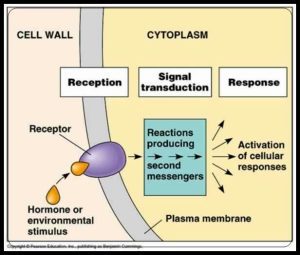

4.3 Signal Transduction: Understanding How Cells Communicate and Respond
Cell communication is at the heart of how living organisms function and adapt to their environment. This process allows cells to respond effectively to internal and external stimuli, which is crucial for maintaining homeostasis and supporting growth, repair, and various other cellular activities. In this section, we’ll explore how the environment influences cellular responses and the fundamental role of signal transduction pathways.
Table of Contents
ToggleCell Communication: Influences from the Environment
Cells constantly respond to environmental changes to ensure survival and proper function. Various external factors, such as temperature, light, and chemicals, can alter how cells behave and how the cell cycle progresses. For example, changes in temperature can affect enzyme activity, while light can influence plant cell responses. These environmental signals activate intracellular pathways that regulate gene expression and alter cell function.
A great example of environmental influence on cellular behavior is “quorum sensing” in bacteria. Quorum sensing is a form of cell communication that enables bacteria to detect population density by producing and sensing signaling molecules called ligands. Once the concentration of these ligands reaches a threshold, it triggers a coordinated response—like releasing toxins to infect a host—allowing bacteria to act in synchrony.
Signal Transduction and Its Impact on Cellular Responses
Signal transduction is a vital cellular process that translates external signals into specific cellular responses. The process involves three core steps: reception, transduction, and response. These steps ensure that a signal from the environment is recognized by the cell and leads to an appropriate response.

Reception: This is when a signaling molecule, known as a ligand, binds to a receptor on the cell’s surface. The receptor changes shape to initiate the next phase—transduction.
Transduction: The signal is amplified and transmitted within the cell, often involving a cascade of molecular events. This can be compared to a waterfall or a line of dominoes falling—once one event starts, it triggers the next in a series, known as the cascade effect.
Response: Finally, the cell responds to the signal, which could mean activating specific genes, initiating protein synthesis, or altering cellular metabolism.
The signal transduction pathways can also lead to changes in a wide range of cellular processes, including differentiation, shape, metabolism, and even cell death. This is why proper function of these pathways is crucial for avoiding harmful disorders and diseases.
Gene Expression and Signal Transduction
Gene expression is the process by which a cell takes the instructions encoded in DNA and converts them into functional products, usually proteins. Signal transduction can significantly impact gene expression by regulating how much of a protein is produced. This can either enhance or suppress specific cellular functions based on the signal received.
A great example of this is the regulation of blood sugar levels using insulin and glucagon. These hormones play opposing roles in maintaining glucose homeostasis in the bloodstream:
High Blood Sugar: When you consume food and blood glucose levels rise, the pancreas releases insulin into the bloodstream. Insulin signals the liver to store excess glucose as glycogen, thereby reducing blood sugar levels.
Low Blood Sugar: On the other hand, when blood glucose levels drop, the pancreas releases glucagon. Glucagon prompts the liver to break down glycogen into glucose and release it into the bloodstream, restoring normal blood sugar levels.
In both cases, the interaction between insulin, glucagon, and the liver involves signal transduction pathways, which maintain a stable internal environment essential for life.
Signal Transduction Pathways and Their Broader Role
Signal transduction pathways don’t just control metabolism; they also influence crucial cellular activities like:
Cell Death (Apoptosis): Signal transduction can initiate programmed cell death, which is a vital process for removing damaged or unwanted cells.
Cell Differentiation: Signals from other cells or the environment can influence how stem cells differentiate into specific cell types, supporting growth and development.
Changes in Cell Shape: Signals can prompt cytoskeletal modifications, which affect cell movement and structure.
Metabolism Adjustments: Cellular metabolism can be adjusted in response to signals, ensuring cells have the resources they need at any given time.
The efficient functioning of signal transduction pathways is essential for organisms to adapt to changing environments and maintain homeostasis. Errors or disruptions in these pathways can result in diseases like diabetes, cancer, or autoimmune disorders.
Quorum Sensing: A Unique Case of Bacterial Communication
Quorum sensing is a form of signal transduction seen in bacteria that allows them to coordinate behavior based on population density. Bacteria produce signaling molecules, and once these molecules reach a critical concentration, they trigger a response that benefits the entire population. For example, certain bacteria release toxins only when their population is large enough to overwhelm the host’s defenses. This strategic behavior maximizes their chances of survival and proliferation.
Takeaways
Signal transduction is a foundational concept in understanding how cells communicate, adapt, and maintain their essential functions. Whether it’s regulating blood sugar, responding to environmental changes, or communicating between bacterial cells, the principles of signal reception, transduction, and response are universal. This intricate system is constantly at work, ensuring our bodies function properly and remain balanced.
To summarize, the key steps of signal transduction involve:
Reception: The signal is detected by the target cell.
Transduction: The signal is relayed and often amplified.
Response: The cell carries out the appropriate response, such as changing gene expression or modifying cell behavior.
Understanding signal transduction pathways provides insights into the complex mechanisms of life and reveals the interconnectedness of all living systems.

Recent Posts
- 6.2 Expansion of Imperialism
- 6.1 Rationales for Imperialism
- This Extremely Simple Math Problem Is Going Viral
- What is ChatGPT?
- Can USB Port be Converted to HDMI?
- Unit 6 Overview: Consequences of Industrialization
- Marxist lens
- Instagram, Tiktok Links Not Opening, Safari Opening Instead – How to Fix
- Top 10 Test Taking Tips for the Digital SAT
- 3.4 First Amendment: Freedom of the Press
- 6.10 Challenges of Urban Changes
- 4.5 Measuring Public Opinion
- 3.3 Survivorship Curves
- 7.7 Finding Particular Solutions Using Initial Conditions and Separation of Variables
- Societal Expectation
Choose Topic
- ACT (17)
- AP (20)
- AP Art and Design (5)
- AP Physics 1 (1)
- AQA (5)
- Artificial intelligence (AI) (2)
- Banking and Finance (6)
- Biology (13)
- Business Ideas (68)
- Calculator (72)
- ChatGPT (1)
- Chemistry (3)
- Colleges Rankings (48)
- Computer Science (4)
- Conversion Tools (136)
- Cosmetic Procedures (50)
- Cryptocurrency (49)
- Edexcel (4)
- English (1)
- Environmental Science (2)
- Exam Updates (1)
- Finance (17)
- Fitness & Wellness (164)
- Free Learning Resources (190)
- GCSE (1)
- General Guides (40)
- Health (107)
- History and Social Sciences (149)
- IB (1)
- IGCSE (2)
- Image Converters (3)
- IMF (10)
- Math (39)
- Mental Health (58)
- News (8)
- OCR (3)
- Past Papers (463)
- Physics (5)
- SAT (39)
- Schools (3)
- Sciences (1)
- Short Notes (5)
- Study Guides (27)
- Syllabus (19)
- Tools (1)
- Tutoring (1)
Recent Comments


Instagram, Tiktok Links Not Opening, Safari Opening Instead - How to Fix


Can You Use a PCIe Express 3.0 Card In a 2.0 Slot?


IB Maths: AA HL 1.1 Algebra ToolKit






